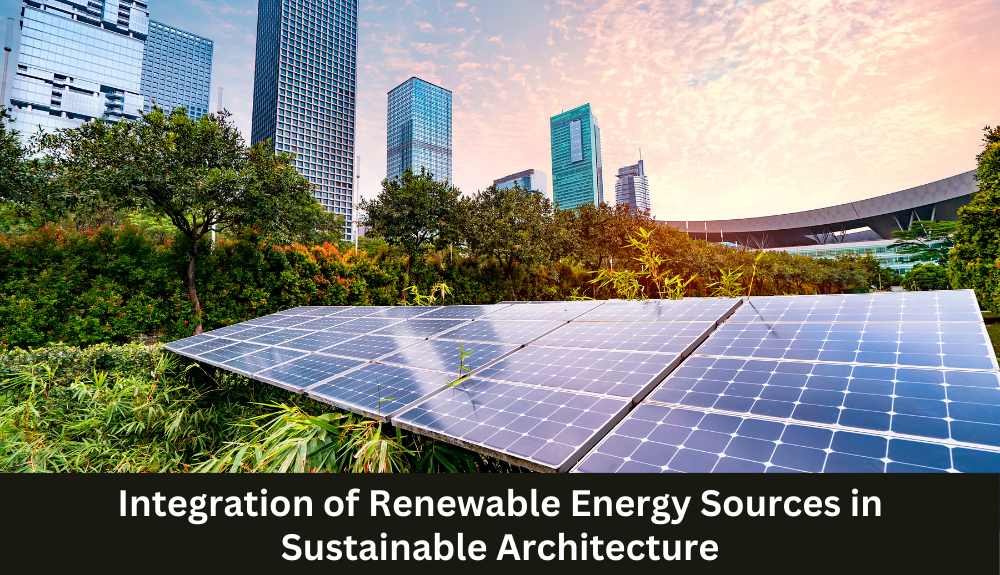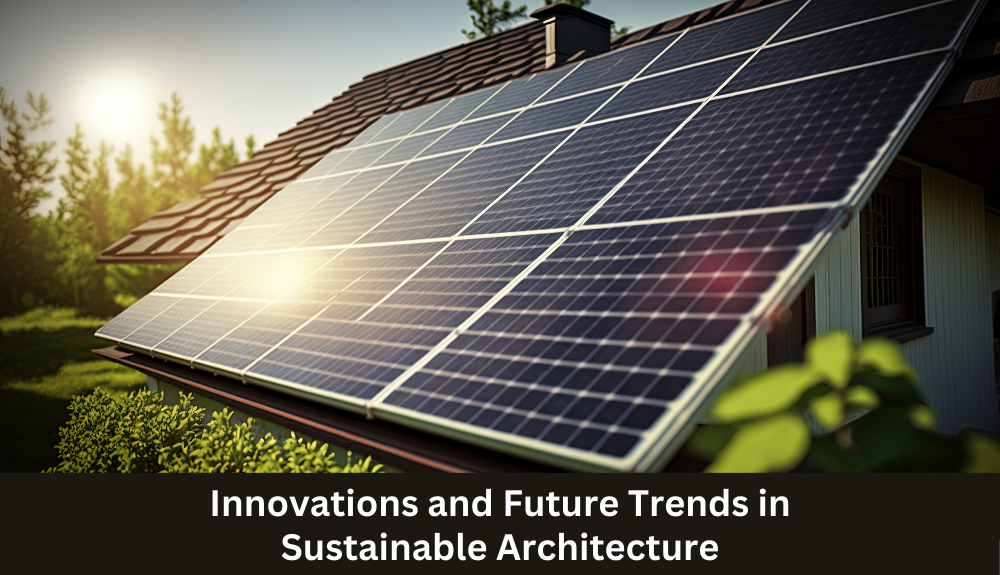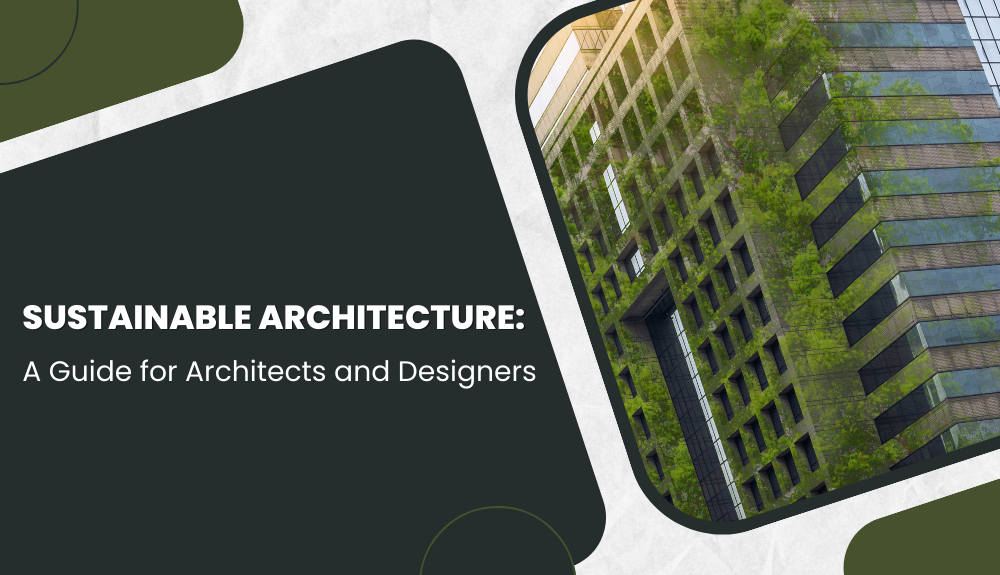Are you ready to shape the cities of tomorrow with sustainable architecture that not only enhances urban landscapes but also ensures a greener and more efficient future? Imagine a world where every building is a beacon of sustainability, blending seamlessly with nature while minimizing energy consumption and environmental impact.
In our blog, “Sustainable Architecture: A Guide for Architects and Designers,” we delve into the key principles and strategies of sustainable design, offering you a roadmap to create energy-efficient buildings and vibrant urban spaces. From innovative green roofs to cutting-edge solar panel technology, we explore how integrating sustainable architecture can revolutionize the way we build and live in cities.
Join us as we uncover inspiring case studies, insightful design strategies, and impactful environmental solutions that showcase the pivotal role of architecture in fostering sustainable communities. Get ready to unlock the potential of sustainable architecture and embark on a journey towards a more eco-conscious and resilient future.
Get inspired by the fascinating world of sustainable architecture and discover how every structure can be a testament to both creativity and environmental responsibility.
Introduction to Sustainable Architecture
Sustainable architecture is a design approach focused on creating energy-efficient buildings and sustainable urban spaces. It integrates principles and strategies that minimize negative environmental impacts while promoting the well-being of occupants and the surrounding community. By considering factors such as energy efficiency, material selection, water conservation, and green spaces, sustainable architecture aims to create a harmonious balance between the built environment and nature.
One of the main goals of sustainable architecture is to reduce energy consumption and greenhouse gas emissions. This is achieved through the use of renewable energy sources, energy-efficient building materials, and advanced technologies. Additionally, sustainable architecture fosters the creation of livable and inclusive communities by prioritizing accessibility, functionality, and social interaction.
By incorporating sustainable design principles into their projects, architects and designers can contribute to the conservation of resources, the mitigation of climate change, and the improvement of overall environmental quality. Sustainable architecture plays a crucial role in shaping the future of our cities, creating spaces that are not only aesthetically pleasing but also contribute to the well-being of both individuals and the planet.
As the demand for sustainable development continues to grow, architects and designers must stay updated with the latest trends, innovations, and best practices in sustainable architecture. This article will delve deeper into the key principles, strategies, and examples of sustainable architecture, offering valuable insights and guidance for those looking to incorporate sustainability into their designs.
Sustainable Architecture: Key Principles and Strategies
Sustainable architecture encompasses a wide range of principles and strategies aimed at designing energy-efficient buildings and creating eco-friendly urban spaces. By incorporating these practices, architects and designers play a vital role in minimizing environmental impact and maximizing societal well-being.
Energy Efficiency:
One of the fundamental principles of sustainable architecture is energy efficiency. Designers strive to reduce energy consumption by utilizing passive design techniques, optimizing building orientation, and incorporating insulation to minimize heating and cooling needs. The integration of energy-efficient systems, such as LED lighting and smart thermostats, further enhances a building’s energy performance.
Material Selection:
Choosing sustainable materials is essential in minimizing the environmental footprint of a building. Designers opt for eco-friendly materials, including recycled, recyclable, and locally sourced options. They also consider the life cycle assessment of materials to ensure durability, low emissions, and minimal waste during production and disposal.
Water Conservation:
Sustainable architecture emphasizes efficient water management and conservation practices. Designers implement strategies such as rainwater harvesting, greywater recycling, and low-flow fixtures to reduce water consumption. Additionally, incorporating green spaces with permeable surfaces and native plantings helps manage stormwater runoff and promotes biodiversity.
Green Spaces:
Integrating green spaces into architectural designs is crucial for creating sustainable urban environments. Rooftop gardens, vertical greenery, and community parks not only enhance aesthetics but also contribute to improved air quality, temperature regulation, and biodiversity. These green spaces provide opportunities for recreation, relaxation, and overall well-being.
By adhering to these key principles and strategies, architects and designers can contribute to the creation of energy-efficient buildings and sustainable communities. The integration of sustainable practices not only reduces environmental impact but also enhances the quality of life for current and future generations.
Integration of Renewable Energy Sources in Sustainable Architecture

Renewable energy sources play a vital role in sustainable architecture by reducing dependence on fossil fuels and minimizing carbon emissions. Architects and designers are incorporating various techniques and technologies to integrate renewable energy sources seamlessly into building design. Let’s explore some of these innovative solutions:
Solar Panels
One of the most popular and widely adopted renewable energy technologies is the use of solar panels. These panels convert sunlight into electricity, reducing the reliance on traditional energy sources. By strategically integrating solar panels into buildings, architects can harness solar energy to power lighting, heating, and cooling systems.
Smart Grid Systems
Smart grid systems enable the efficient distribution and consumption of electricity by incorporating advanced communication and control technologies. By connecting renewable energy sources, like solar panels, to smart grids, architects can optimize energy usage, reduce wastage, and ensure a more sustainable energy infrastructure.
Wind Turbines
In certain locations with consistent wind patterns, wind turbines can be integrated into the architecture to generate clean electricity. These turbines harness wind energy and convert it into usable power, contributing to a sustainable energy mix.
Geothermal Systems
Geothermal systems utilize the natural heat from below the Earth’s surface to provide heating and cooling for buildings. By tapping into the stable temperatures underground, architects can significantly reduce energy consumption and carbon emissions.
Biomass Energy
Biomass refers to organic materials, such as wood pellets or agricultural waste, that can be burned to produce heat or electricity. Designing buildings to incorporate biomass energy systems enables the utilization of renewable and carbon-neutral energy sources.
By intelligently integrating these renewable energy sources into building design, sustainable architects can create energy-efficient structures that have a minimal environmental impact. These innovative technologies pave the way for a greener and more sustainable future in the realm of architecture.
Designing Energy-Efficient Public Spaces Beyond Building Boundaries
In sustainable architecture, the focus is not only on designing energy-efficient buildings but also on creating sustainable public spaces that extend beyond the physical boundaries of a structure. These spaces play a crucial role in promoting environmental sustainability, enhancing the quality of urban life, and fostering a sense of community. By incorporating innovative strategies and technologies, architects and urban planners can transform public spaces into energy-efficient environments that contribute to the overall sustainability of a city.
Smart Lighting Systems
One of the key strategies for designing energy-efficient public spaces is the implementation of smart lighting systems. By utilizing motion sensors and advanced controls, lighting can be optimized to minimize energy consumption. These systems automatically adjust lighting levels based on occupancy and ambient light, ensuring that energy is not wasted when spaces are unoccupied or during daylight hours.
Efficient Water Management
Efficient water management is another crucial aspect of designing energy-efficient public spaces. By incorporating technologies like rainwater harvesting and greywater recycling systems, architects can reduce the reliance on fresh water resources. These systems collect and treat rainwater or wastewater for non-potable uses, such as irrigation or toilet flushing, thereby conserving precious water resources.
Green Roofs
Green roofs are gaining popularity as a sustainable feature in public spaces. These vegetated roof systems help to mitigate the urban heat island effect, reduce stormwater runoff, and improve air quality. Green roofs also provide aesthetic benefits, creating pleasant green spaces for people to enjoy while reducing the energy consumption of buildings by insulating them.
By implementing these strategies and technologies, architects can create energy-efficient public spaces that contribute to a sustainable urban environment. Such spaces not only improve the quality of life for residents and visitors but also help to address environmental challenges such as climate change and resource depletion. Designing energy-efficient public spaces is a pivotal aspect of sustainable architecture, and architects, urban planners, and construction companies must work together to integrate these strategies into their projects.
Revitalizing Urban Landscapes with Energy-Efficient Designs
As cities continue to experience rapid urbanization, the need for energy-efficient designs in urban landscapes becomes crucial. By incorporating sustainable architectural practices, it is possible to revitalize urban areas while reducing energy consumption and promoting sustainable development. Here are some key features and strategies that enhance energy efficiency in urban landscapes:
Smart Lighting Systems
Integrating smart lighting systems can significantly reduce energy consumption in urban areas. By using motion sensors and timers, streetlights and outdoor lighting can be optimized to only illuminate when needed. This not only saves energy but also improves safety and reduces light pollution.
Efficient Water Management
Efficient water management is another important aspect of energy-efficient urban design. Implementing water-saving technologies such as rainwater harvesting and graywater recycling systems can help reduce water consumption. Additionally, using native plants and green infrastructure can minimize the need for excessive irrigation.
Green Roofs
Green roofs, also known as living roofs, are an effective way to mitigate the urban heat island effect and improve energy efficiency. These roofs are covered with vegetation, which provides insulation, reduces heat absorption, and promotes biodiversity. Green roofs also help in reducing stormwater runoff and improving air quality.
Sustainable Materials
Using sustainable materials in the construction of urban infrastructure can have a significant impact on energy efficiency. Utilizing locally sourced and recycled materials can reduce the carbon footprint associated with transportation and manufacturing processes. Additionally, incorporating energy-efficient building materials and techniques can improve insulation and reduce energy consumption.
Promoting Active Transportation
Designing urban landscapes that prioritize walking, cycling, and public transit can help reduce dependency on private vehicles and decrease carbon emissions. Integrated pedestrian and cycling infrastructure, along with accessible and efficient public transit systems, encourage residents to opt for sustainable modes of transportation.
By incorporating these key features and strategies into urban design, architects and urban planners can revitalize landscapes and create sustainable communities. Energy-efficient designs not only reduce environmental impact but also contribute to improved air quality, enhanced livability, and long-term economic development. As the world continues to grapple with the challenges of rapid urbanization and climate change, sustainable architecture plays a pivotal role in creating a sustainable and thriving future for our cities.
Innovations and Future Trends in Sustainable Architecture

The field of sustainable architecture is constantly evolving, driven by a need to address environmental challenges and create a more sustainable future. Today, architects and designers are exploring innovative materials, technologies, and sustainable urban planning strategies to push the boundaries of sustainable architecture.
Advancements in Materials
One notable trend in sustainable architecture is the use of advanced materials that have a low environmental impact. For instance, bio-based materials derived from renewable resources, such as bamboo and reclaimed wood, are gaining popularity due to their durability and reduced carbon footprint. Additionally, the development of self-healing materials, which can repair cracks and damages over time, contributes to the longevity and sustainability of buildings.
Embracing Technology
Technological advancements are playing a significant role in shaping the future of sustainable architecture. Smart buildings equipped with energy-efficient systems, automated controls, and sensors that monitor energy consumption and optimize resource usage are becoming increasingly common. Integration of renewable energy sources, such as photovoltaic panels and wind turbines, allows buildings to generate their own clean energy, reducing their reliance on conventional power sources.
Sustainable Urban Planning
Sustainable architecture goes beyond individual buildings and extends to the design of entire urban areas. The concept of sustainable urban planning involves creating walkable communities, promoting mixed land use, and incorporating green spaces to improve air quality and reduce the urban heat island effect. Additionally, incorporating electric vehicle infrastructure and designing buildings with sustainable transportation options in mind contribute to a more environmentally friendly and accessible urban environment.
A Holistic Approach
The future of sustainable architecture lies in taking a holistic approach that considers the entire life cycle of a building. This includes adopting construction practices that minimize waste and maximize the efficient use of materials. Implementing strategies for efficient water management, such as rainwater harvesting and graywater recycling, further enhances the sustainability of buildings. Furthermore, the integration of smart lighting systems, which automatically adjust to natural light levels, reduces energy consumption and enhances occupant comfort.
As the world faces the challenges of climate change and rapid urbanization, sustainable architecture will continue to evolve to address these issues. By embracing innovative materials, technologies, and sustainable urban planning, architects and designers can create buildings and urban spaces that are not only environmentally friendly but also promote a high quality of life for inhabitants. The future of sustainable architecture is promising, as it strives to meet the demands of the present while paving the way for a sustainable and thriving future.
Sustainability Standards and Certifications in Architecture
When it comes to sustainable architecture, adhering to recognized standards and certifications is essential in ensuring the environmental impact of buildings is minimized. These standards and certifications provide guidelines and benchmarks for designers, architects, and construction companies to follow in order to create eco-friendly structures. By obtaining these certifications, professionals showcase their commitment to sustainability and contribute to the larger goal of creating a more sustainable future.
One widely recognized sustainability standard is LEED (Leadership in Energy and Environmental Design), developed by the U.S. Green Building Council. LEED certification evaluates the design, construction, and operation of buildings based on their energy efficiency, water usage, waste management, and indoor environmental quality. It provides a framework for incorporating sustainable practices throughout the entire building lifecycle.
Another notable certification is BREEAM (Building Research Establishment Environmental Assessment Method), which originated in the United Kingdom. BREEAM assesses buildings based on factors such as energy and water usage, materials, waste management, and ecological impact. It focuses on mitigating environmental challenges and promoting sustainable development.
To obtain these certifications, professionals must complete a rigorous evaluation process. This typically involves submitting documentation, conducting site visits, and demonstrating compliance with the specific criteria set by the certification body. The process ensures that buildings meet high sustainability standards and align with the principles of sustainable architecture.
By adhering to sustainability standards and obtaining certifications, architects and designers can showcase their commitment to creating buildings with a low environmental impact. These certifications also provide assurance to clients and stakeholders that the building has been designed and constructed with sustainability in mind. Moreover, by following these standards, professionals contribute to the larger goal of reducing carbon emissions, conserving resources, and creating a more sustainable built environment.
Remember, sustainability standards and certifications play a pivotal role in driving the adoption of sustainable practices in architecture. By incorporating these guidelines into projects, professionals contribute to a greener future and help shape the sustainable cities of tomorrow.
Conclusion
In conclusion, sustainable architecture plays a vital role in designing energy-efficient buildings and creating sustainable urban spaces. By incorporating key principles and strategies, architects and designers can contribute to a greener and more sustainable future.
Throughout this article, we have explored the significance of sustainable architecture in enhancing energy efficiency, promoting environmental sustainability, and creating livable communities. By focusing on energy efficiency, material selection, water conservation, and green spaces, architects can minimize the environmental impact of buildings and ensure long-term sustainability.
Integrating renewable energy sources, such as solar panels and smart grid systems, further enhances the energy efficiency of buildings. Additionally, designing energy-efficient public spaces beyond building boundaries, utilizing strategies like smart lighting systems, efficient water management, and green roofs, contributes to a sustainable urban environment.
Revitalizing urban landscapes with energy-efficient designs and embracing innovations and future trends in sustainable architecture are essential for combating climate change and promoting sustainable development. By adhering to sustainability standards and certifications, architects can ensure that their buildings meet the highest environmental standards.
Real-world case studies highlight the practical application of sustainable architecture and the positive impact it has on energy efficiency and sustainability. These examples demonstrate that sustainable design is not only achievable but also economically beneficial.
In the face of rapid urbanization and increasing global energy demand, sustainable architecture emerges as a pivotal force in creating a sustainable and resilient future. By prioritizing energy efficiency, environmental sustainability, and the well-being of communities, architects and designers can shape the world into a better place for future generations.
Remember, sustainable architecture is not just a trend but a necessity in building a sustainable future. Let’s embrace this fascinating world of sustainable architecture and collectively create amazing buildings that contribute to a sustainable future for all.



